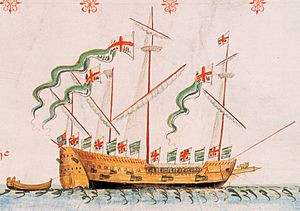Salamander of Leith facts for kids

The galleass Salamander, in the Anthony Roll
|
|
Quick facts for kids History |
|
|---|---|
| Name | Salamander |
| Builder | French |
| Laid down | Unknown |
| Launched | Unknown |
| Acquired | 1537 |
| In service | 1537 |
| Out of service | 1544 |
| Captured | 1544 |
| Fate | Unknown |
| Notes | Used against Scotland in 1547 by England. |
| General characteristics | |
| Class and type | Warship |
| Tons burthen | 300 tons |
| Propulsion | Sails |
| Complement | 220 |
| Armament |
|
The Salamander was a powerful warship from the 1500s. She belonged to the Royal Scots Navy, which was Scotland's navy at the time. This ship was a special wedding gift from Francis I of France, the King of France, to James V of Scotland, the Scottish King.
Scotland's Royal Warship
When King James V and his first wife, Madeleine of Valois, arrived in Scotland in 1537, they brought many ships. Two of these, the Salamander and the Morischer (also called Great Unicorn), were gifts from France. These were described as "great ships for the wars." The Salamander was even repaired in France before sailing to Scotland.
After some important work, the Salamander became a very busy ship. In 1538, King James V used her for a trip to the Isle of May. Later that year, she sailed back to France to bring James V's new queen, Mary of Guise, to Scotland. Other Scottish and French ships sailed with her.
The Salamander became the most important ship in the Scottish fleet, known as the king's flagship. In 1538, she got new equipment like a compass and four clocks. By 1540, she was fitted with many large and small guns. Workers also checked and fixed her 22 crossbows and 9 small handguns. The ship was even "gallantry trimmed with painting and gilding," meaning she was beautifully decorated.
In June 1540, King James V sailed on the Salamander from Leith. He led a fleet of 15 ships, including the Mary Willoughby and the Great Lion. They sailed north to Kirkwall in Orkney and then to Lewis in the west. This trip helped the king show his power across his kingdom.
In 1542, the Salamander, along with the Mary Willoughby and the Lion, attacked merchant ships and fishermen near Whitby, England. Later that year, these same ships blocked an English merchant ship called the Antony of Bruges in a bay in France.
In 1544, during a conflict known as the Rough Wooing, the English army attacked Scotland. The Salamander and another Scottish ship, the Unicorn, were captured at Leith. The English then used these ships to carry their soldiers and supplies back home after they had burned parts of Edinburgh.
When the Salamander joined the English fleet, she was listed as a 300-ton ship with 220 crew members and 20 gunners. She carried many different types of guns, including brass cannons, iron guns, and handguns. She also had 140 bows, 90 bills (a type of weapon), and 70 pikes (long spears). The Salamander had about half the number of weapons as the famous English flagship, the Mary Rose.
The Salamander and the Unicorn returned to Scotland in 1547 as part of an English invasion fleet. They likely helped by firing their cannons during the Battle of Pinkie. The Salamander was later part of an English fleet that sailed to Orkney in 1557. She might have been destroyed as late as 1574, meaning she had a very long life for a ship of that time.

